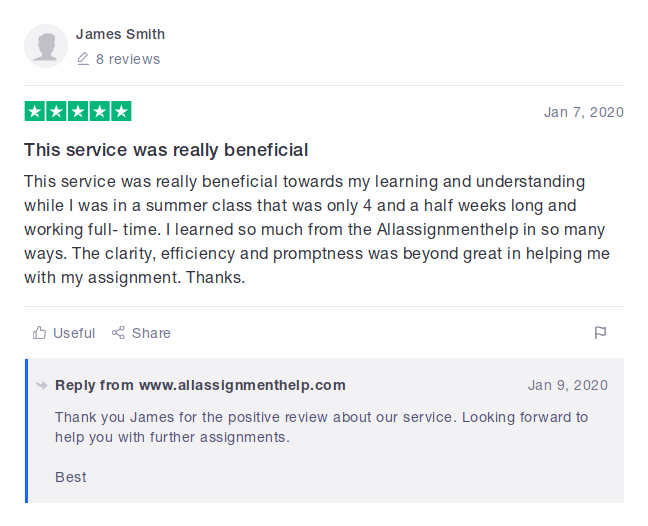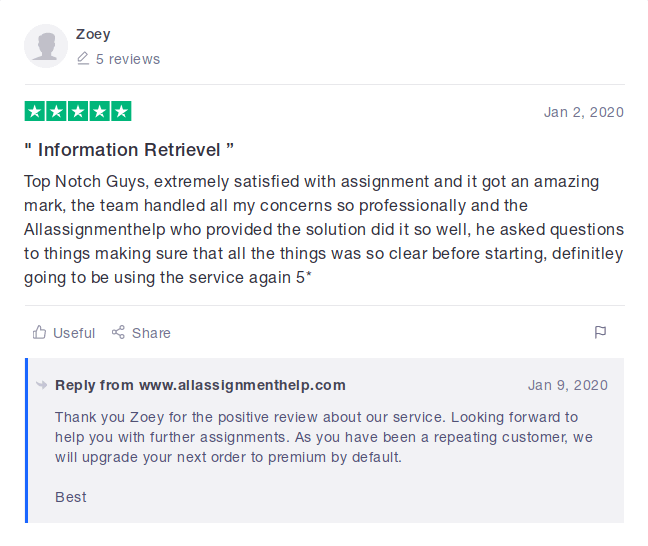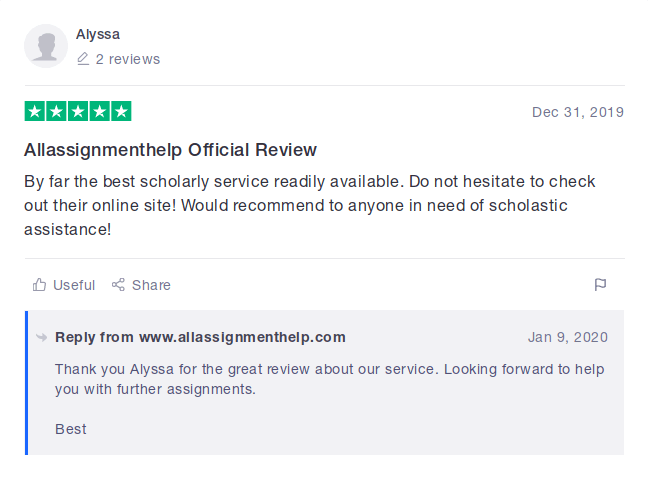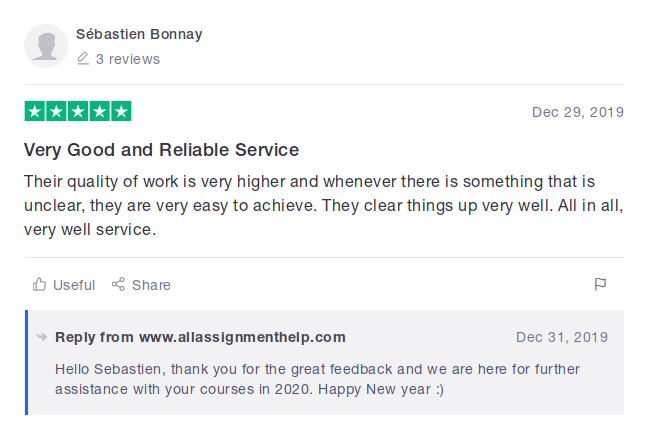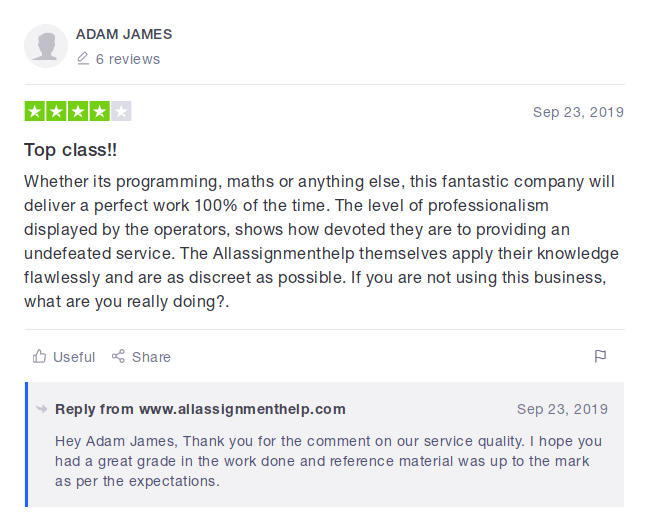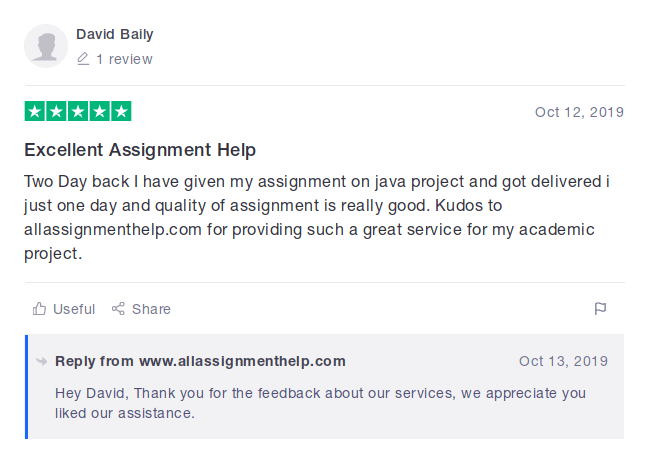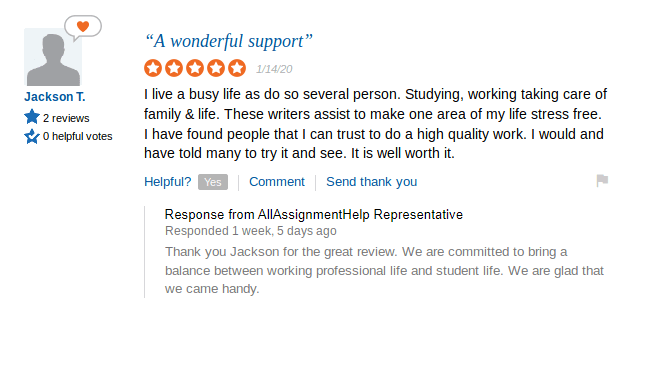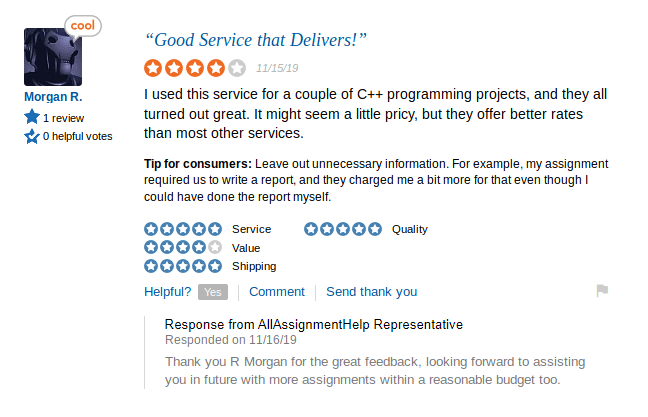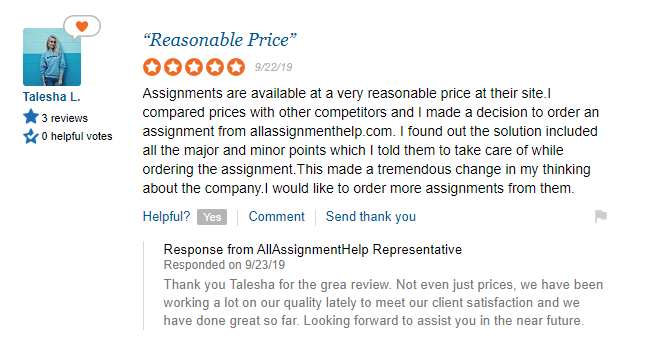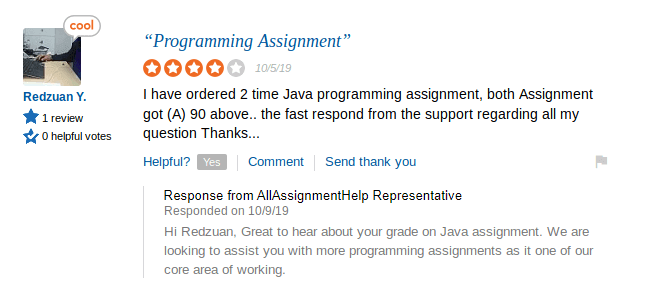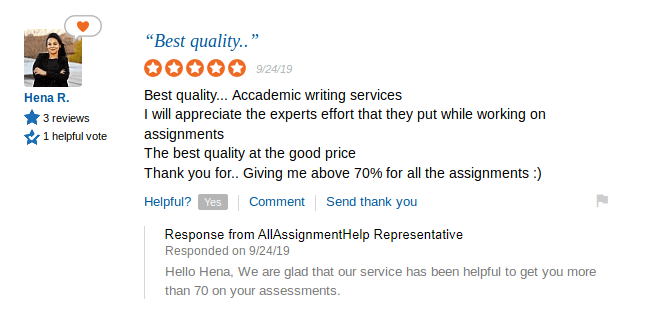Why students order last minute assistance with assignments from us
You have the flexibility to chose an assignment expert that suits your budget and quality parameters. We have more than 2000 PhD experts available to assist with assignments.
-
Order Preview Before Final Work
You get a preview before making final payment.
-
Pay Using different channels
You can pay using multiple secure channels, such as PayPal or Credit Cards.
-
Plagiarism Free Work Guaranteed
We sent unique content with no plagiarism.
-
Ping Us On Live Chat
You can talk to us anytime around the clock. We are up for the support.
-
Choose Your Own Expert
We let you chose from the pool of 2000 PhDs tutors.
-
Go Mobile
You do not need to be on laptop all the time, our mobile interface is great to use.
Reviews and Trust Go Hand In Hand
Allassignmenthelp.com has garnered nothing but praise from the clients. Any trustworthy review platform has positive review about our service and gives us motivation to improve.
Claim Your Offer
30% OFF & 150% Cashback on your First order !
Type your whatsapp number to get an exclusive code.
Recent Completed Projects
You can look at some of the samples that we did recently, we strongly recommend not to use samples for writing your assignment.
You are just a click away from getting the best assignment help service
Don't worry anymore as we are here for you.
Place Your OrderIntroduction
The current report is concerned with the web-based IMS and CMS for managing an online estate agency. The agency for which the website is being made is in real estate and the company is a family run business. The agency is willing to establish a website that will aid in handling the various aspects of the real estate activities. The focus of the website is to market the products and the services to the target customers. The target customers will be the people who are willing to make any form of purchase in the real estate. There are various other purposes that are expected to be achieved through this development. One such development is to allow the public to view the online show-room. The website will act as an online show room where various forms of properties will be available for sale along with their respective images. The users can browse through these properties and collect information as per the requirements. The focus of the web portal would also be to allow the customers to register their details along with the properties in which they are interested.
Along with these things, there are various other functionalities and facilities that are expected to be available on the website and help the users in getting seamless experience. These specifications and functionalities are discussed in the next chapter. Along with the specification and functionalities, the chapter covers the schedule under which the development for the web portal will be made and the deliverables that will be expected by the end of the project. The third chapter will be discussing various process models that can be considered for the development of the current project. The various models have been selected and compared to identify the suitable one for the web portal development. The fourth chapter discusses the first release of the system that will be implemented for the real estate agency. The major focus of this section will be on the look and feel of the website. There will be few screenshots for the websites. The functionalities will be more like structural and at present less focus will be on the aesthetics of the website.
System specification
The current system is expected to cover three aspects, namely, web portal, CMS and IMS. The Web Portal will be the front end on the side of the users. This will be used by the users to conduct all the browsing activities they are willing to do regarding the real estate information search. The CMS refers to the content management system (McKeever, 2003). This will be handled by the internal team at the agency and it will be used to modify or update the information on the web portal. The various other forms of functionalities are mentioned in the section below. The third module to be included is the IMS, that is, Information Management System. The information management system will help in the storage and retrieval of the information (Laudon&Laudon, 2004). The IMS will help the management in making managerial decisions as and when required. The functionalities on this aspect have been discussed in the next section.
Functionality
The first module of the system being developed is a Web Portal.The web portal will be for the users or the customers of the agency. The users will be visiting the web portal to fulfil their need regarding the real estate information. The web portal will be available for public to view and will act as an online showroom for real estate properties. It will also have information regarding various services that are provided by the agency such as customer specific services. The web portal will have properties that are for sale. The search bar will allow the customers to search for the properties as per given filters. The customers can collect information about particular property from the portal. The users can also save their searches as history to view later. It can be done category wise or location wise. The contact box will allow book appointment with the sales team which will be used for booking further.The web portal will also have login facilities for the employees of the agency. The employees will be able to login and take customer queries received from the contact page.
The second module of the system is CMS or Content Management System. The content that will be available on the portal requires management so that it stays fresh and relevant to the users visiting to the portal. The content management system will be available for the members of the agency and can be managed by them only. This is the back end aspect of the online show room. The content management system will allow the members to do the following few things:
- The staffs can upload and edit photos of properties, locations, prices, and the description.
- The staff members can also make advertisements on the pages displaying the products. These can be any kind of special offers, latest property entries in the market.
- The back end will have secure login facility for the individual staff members. All the members will have their individual profile through which they will login and make changes as per the requirement.
The third aspect is the Information Management System. The information management system, like the content management system, will be handled by the agency staff members only. The IMS will allow the users to manage relevant information regarding the business.
They are:
- Purchase and sales date of properties
- Sellers and buyers detail
- Staff member details
- Event details
- Services on offer details. This will include property evaluation, removals, and independent mortgage brokerage.
- The main page will have login form.
- The login will take staff members to detailed page showing navigation menus such as property search, property reports, add new, move, etc.
- All property, buyer, seller, and staff details will be attached with unique id which will be used in IMS to pull respective information. This can be further generated in excel sheet.
"I was stuck between my tournament and essay assignment. I thought I would have to quit on one of them. But, a friend told that the services of AllAssignmentHelp UK are reliable. I am glad that I followed his advice and chose them for writing my essays. They wrote them withsuch a perfection that I got top grades. Their research was impeccable. Even I would not have done such an extensive research."
George Jones,
London
Development schedule
The development process of the current system constituting the three modules for real estate agency is equivalent to management of a project. Therefore, it is important that all the necessary aspects of a typical project management are covered. The key elements in a particular project are the schedule of the project activities and the deliverables. The current section discusses the development schedule for the system which contains the activities to be handled and the expected start date and end date (“Project Management Institute”, 1987). The project schedule refers to the listing of the activities that are expected to be completed within certain timeline. A schedule is commonly used in the project management or portfolio management to ensure that the project development can be easier to track. Generally the project schedule is managed and handled by project schedulerhowever in the current project the development team will handle the same (Duncan, 1996). The table below details these specifications:
| Activities | Start Date | End Date |
|---|---|---|
| Identify Project Scope | April 3, 2017 | April 4, 2017 |
| Define user audience | April 5, 2017 | April 5, 2017 |
| Specify goals and objectives | April 6, 2017 | April 6, 2017 |
| Identify Process model | April 7, 2017 | April 7, 2017 |
| Implement process model | April 7, 2017 | April 8, 2017 |
| Develop wire frame | April 9, 2017 | April 10, 2017 |
| Develop initial code | April 11, 2017 | April 12, 2017 |
| Develop sample screenshots | April 13, 2017 | April 13, 2017 |
| Initial review | April 14, 2017 | April 15, 2017 |
| Final code development | April 16, 2017 | April 30, 2017 |
| Final arrangements | May 1, 2017 | May 5, 2017 |
| Integration testing | May 6, 2017 | May 10, 2017 |
| User review | May 11, 2017 | May 12, 2017 |
| Project closure | May 13, 2017 | May 13, 2017 |
The activities given above are not exhaustive there is the possibility of changes in the future depending on the work requirement. In the development of web portals or any other software, it is important that the timeline is kept flexible (Cleland, 1996). The flexibility in the schedule is the key to ensure that the project is handled effectively. Every project faces some kind of challenges during the progress and therefore the constant updates on the project schedule are necessary.
Deliverables
Deliverables refer to the tangible or intangible products that are to be produced by the end of a particular project. The deliverables are the final outputs that are expected to be achieved by the project team after completing the project (Chapman & Ward, 1996). The deliverables, in general, can be different things such as constructed house, machine, or software product. There is also possibility that the deliverables can be multiple things instead of one final product. There are various deliverables for the current project that are expected to be gained by the end of this project development. These deliverables are given below along with the description:
| Deliverables | Description |
|---|---|
| Initial Wireframe | The initial wireframe is the structure of the entire portal, IMS and CMS to be developed. This will give the understanding on the things that are to be developed and way it is to be adjusted throughout the portal. |
| Screenshots | The screenshots are the intermediary deliverables that will be taken after the initial development of the portal. The screenshots will be sent for the approval. This will help the team from the real estate agency get the understanding on where the project is heading. |
| Initial Approval Report | The initial approval report refers to the go ahead sign from the assessment team. This will indicate that the project is moving ahead as per the requirement. The report will also contain some feedback that will be incorporated in the project. Based on the screenshots that will be included in this report, the real estate agency will give improvement suggestions that will be included further. |
| Final Web Portal | This is one of the three modules of the system development that is to be delivered. The web portal will have all the functionalities that have been discussed in the sections earlier. Those functionalities will be the key aspects of this portal. |
| Information Management System | The information management system is the second module in which the real estate agency will be interested. The completion of the information management system covering all the deliverables above will be the key. |
| Content Management System | The content management system is the third module in which the real estate agency will be interested. |
Process model
There are various process models that can be adopted to develop the current system. The selection of the right process model ensures that the project develops without major challenges. Some of the software development process models are waterfall model, agile development, V-Shaped model, spiral method, evolutionary prototyping, and iterative model. Each of these models has their strengths and weaknesses and therefore selection of particular model depends on the client and the stakeholder with whom the project is being developed.The sections ahead in this chapter conducts comparative study of these models based on the past literatures and identify the most suitable model for the current development.
Model Comparison
The first model is the waterfall model. It is a conventional model of project development. The waterfall model has all the activities aligned one after another. The waterfall model states that the initiation of new activities can be done only when the previous activity has finished completely. The model allows no going back from the one point in the development process. This is the conventional approach of project development. The projects that do not require any form of iterations are the suitable candidate for this process (Balaji&Murugaiyan, 2012). There are certain advantage to the waterfall methodology such as this methodology is easier to understand and explain to others such as real estate agency in the current case. Each of the phases has defined deliverables and all the activities are well defined. The reason behind the appropriate definition of the project activities and deliverables is that there are no provisions of going back (Petersen et al, 2009). However, there are certain disadvantages to it such as it is considered in this method that there will be no change in requirements after it gets implemented. Therefore, this method can create issue during the project development if requirements change.
Place Order For A Top Grade Assignment Now
We have some amazing discount offers running for the students
Place Your OrderAnother process model is the V-shaped model that has been developed on waterfall model. The only difference is that the testing phases have been aligned with the current planning to implementation phase. There are some advantages to it such as the deliverables are specific, and is appropriate for the projects that have clear requirements and no changes are required. However, similar to the waterfall, the model has huge inflexibility and can be challenging in the development environment where changes are required (Balaji&Murugaiyan, 2012). Moreover, the model lacks in providing the clear path that should be implemented if any issue arises when the testing is conducted. This model can also pose challenge to the system development if any requirement changes come from the agency.
The third model is the prototyping model in which the prototypes are created to identify and understand the requirements of the client clearly. The prototypes are created for different modules and sent to the client for their feedback. This ensures that the iterations are significantly reduced. In this method, it is required that the client should give all the update requirements in the preliminary development, as when the final prototype will be developed, it will be considered final (Boehm, 1991). There are various types of prototyping models such as throwaway prototyping, evolutionary prototyping, incremental prototyping, and extreme prototyping. The use of these prototyping is in accordance to its nomenclature. Challenges in this model are that it creates confusion for the users in understanding the look and feel of final system just by looking at the prototype.
The fourth model considered for the assessment is the spiral method.The spiral method considers two aspects of the development, the first is the design stage and the second is the prototyping stage. Spiral is the combination of both stages. The model is more beneficial for the projects that are larger in size and are relatively expensive (Boehm, 1988). As for the current system of real estate agency, the cost of production will be low and therefore this model will be less suitable. Some of the advantages of this system are that it helps in realistic estimation of budgets due to bottom up approach, and it allows effective management of risks associated with the project development. However, there are some disadvantages to the current system. Some of the disadvantages are higher cost and time consumption in the achievement of the desired project objectives. Also, it requires the project leader is skilled enough in assessing and managing the risks associated with the project.
The fourth method is the iterative and incremental.This method is the combination of multiple waterfall models together. The reason behind such consideration of multiple small waterfalls is that the focus is to complete the project in repeated cycles. There are some advantages to this method such as it starts producing valuable deliverables from the beginning and thus clients do not need to wait longer (Larman&Basili, 2003). The iteration allows that scarce resources are used effectively. The focus is more on providing value to the customer instead of completing the project process. However, the disadvantage of this system is that the documentation load increases due to number of iterations. Moreover, it calls for increased client involvement and thus the overall duration and the cost of the project increases by unprecedented level.
The fifth and final stage considered for the assessment is the agile process model which is also called as extreme programming. There are numerous iterations considered in phases and in incremental manner. The project progresses in sprints of one month or one week depending on the project size and requirements (Balaji&Murugaiyan, 2012). The advantages of this model are that the inclusion of features becomes easier and the continued communication with all the team members and clients ensure that the project is completed as per the requirements. However, there are certain challenges such as increased duration of the project due to increased changes from the user side.
Note: This is not a complete solution. You can request the complete solution by filling out the order form towards your requested assignment.
Place Order For A Top Grade Assignment Now
We have some amazing discount offers running for the students
Place Your OrderREFERENCES
Balaji, S., &Murugaiyan, M. S. (2012). Waterfall vs. V-Model vs. Agile: A comparative study on SDLC. International Journal of Information Technology and Business Management, 2(1), 26-30.
Bassil, Y. (2012). A simulation model for the waterfall software development life cycle. arXiv preprint arXiv:1205.6904.
Boehm, B. W. (1988). A spiral model of software development and enhancement. Computer, 21(5), 61-72.
Boehm, B. W. (1991). Software risk management: principles and practices. IEEE software, 8(1), 32-41.
Chapman, C., & Ward, S. (1996). Project risk management: processes, techniques and insights. John Wiley.
Cleland, D. L., & Ireland, L. R. (2006). Project management.McGraw-Hill Professional.
Duncan, W. R. (1996). A guide to the project management body of knowledge.
 +1-817-968-5551
+1-817-968-5551 +61-488-839-671
+61-488-839-671 +44-7480-542904
+44-7480-542904
